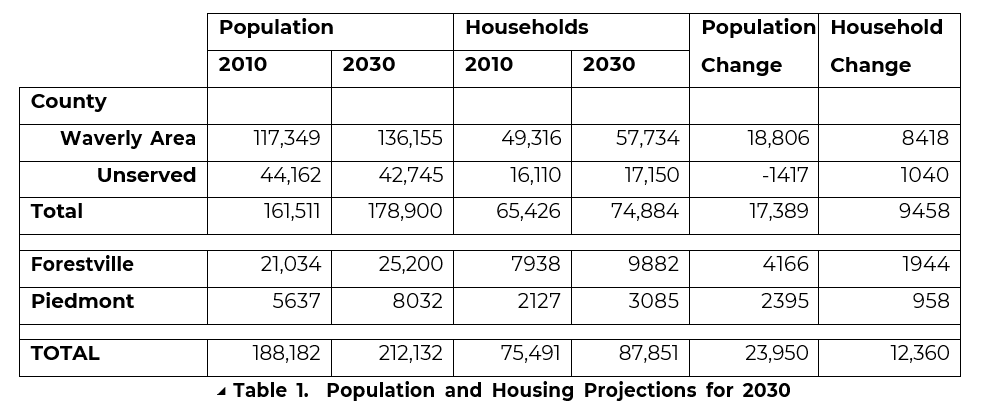Current Statistics and Future Projections
A. Coastmont County
Coastmont County is home to 188,182 residents and has two incorporated towns. The towns range in population from 5,637 in Piedmont to 21,034 in Forestville with 161,511 residents living in unincorporated areas of the county. The county’s comprehensive land use plan incorporates MDP’s projections of modest growth in population and housing. It focuses development in and about the incorporated towns of Forestville and Piedmont, and the designated growth area surrounding the unincorporated Waverly area. Based on past trends, the average household size is projected to decrease. The county projects that population growth outside of the incorporated towns will increase slightly slower than historical trends. The Coastmont County Comprehensive Plan vision statements discourage sprawl by promoting the minimization of impervious surfaces, focused growth within Priority Funding Areas, preservation of the open spaces of the rural areas through minimal zoning and support of the Rural Village concept by requiring cluster type development with forestation requirements and participation in agricultural preservation.
The population and housing growth projections stated in this plan predict an area increase from 188,182 residents/75,491 households in 2010 to 212,132 residents/87,851 households in 2030. The non-municipal portion of this overall growth is 17,389 new residents and 9,458 new households. Of this total growth, 8,418 households will connect to public water and sewer or community systems and 1,040 households will use individual well and septic systems. Currently, 16,110 households are not served by public water or sewer systems. Given these new growth projections, by 2030, 17,150 households are expected to use individual well and septic systems, all located outside of public utility service areas. The county expects that some existing systems will be eliminated when they are connected to public water and sewer systems as annexation occurs, and plans to implement a new policy to require community wastewater treatment systems for subdivisions of four or more lots outside of PFAs or public utility planned service areas.
B. Greater Waverly Area
The Greater Waverly area is home to 119,856 residents/50,295 households, of which 117,349 residents/49,316 households are currently served by the public water and sewer system. Population projections for this area reflect the growth goals stated in this plan, and the projections are in agreement with the projection estimates prepared by the state. The water and sewer service areas are delineated on the land use plan map as growth area. While there are many opportunities for infill development in the existing service area, the county is planning for public utility services to extend beyond the current service area. It anticipates that these services will support 136,155 residents/57,734 households by 2030.
The PFA comment area shown in the land use plan is a group of agricultural parcels located in future water and sewer service areas. These parcels are zoned for low-density development at this time, and landowners are expected to maintain agricultural activities beyond the 2030 time frame. However, there is a need to address stream bank buffers along Coastmont River in this area and to continue support for BMPs by the landowners.
C. Town of Forestville
Forestville is currently home to 21,034 residents/7,938 households and is projected to grow to 25,200 residents/9,882 households by 2030. Forestville’s comprehensive plan update, developed in conjunction with Coastmont County Administration and Planning personnel, identifies three county areas adjacent to the town that it expects to annex. 75% of the new growth or 1,458 households will be located in these areas. 15% of the new growth or 291 households is existing county households requesting annexation for public water and sewer services. The remaining 10% of growth or 195 households is attributed to infill development within current town boundaries. The current public sewer area and water service areas coincide with the town limits and will be expanded to serve new annexations as they occur.
D. Town of Piedmont
The town of Piedmont recently submitted its new comprehensive plan to the state for review and comment prior to adoption by the town commissioners. The current population is 5,637 residents/2,127 households and the plan projects population to increase to 8,032 residents/3,085 households by 2030. The town’s comprehensive plan recommends that a new growth area be added to the west and south of the town. Development studies determined that 25 % of new residents will be within the present town boundaries and 75% will be on annexed lands. A portion of the town’s growth will come from two older county communities developed on septic systems that are experiencing problems and are being considered for annexation to help address nonpoint source loading impacts to Jones Creek. The new connections will require capital improvements to meet water supply demands and wastewater treatment needs.
Please refer to the land use maps for Coastmont County and the town for delineated growth areas and comprehensive land use information. Table 1 below and Table 2 on page 48 provide the 2030 projected population and household figures and associated water and wastewater demands.
